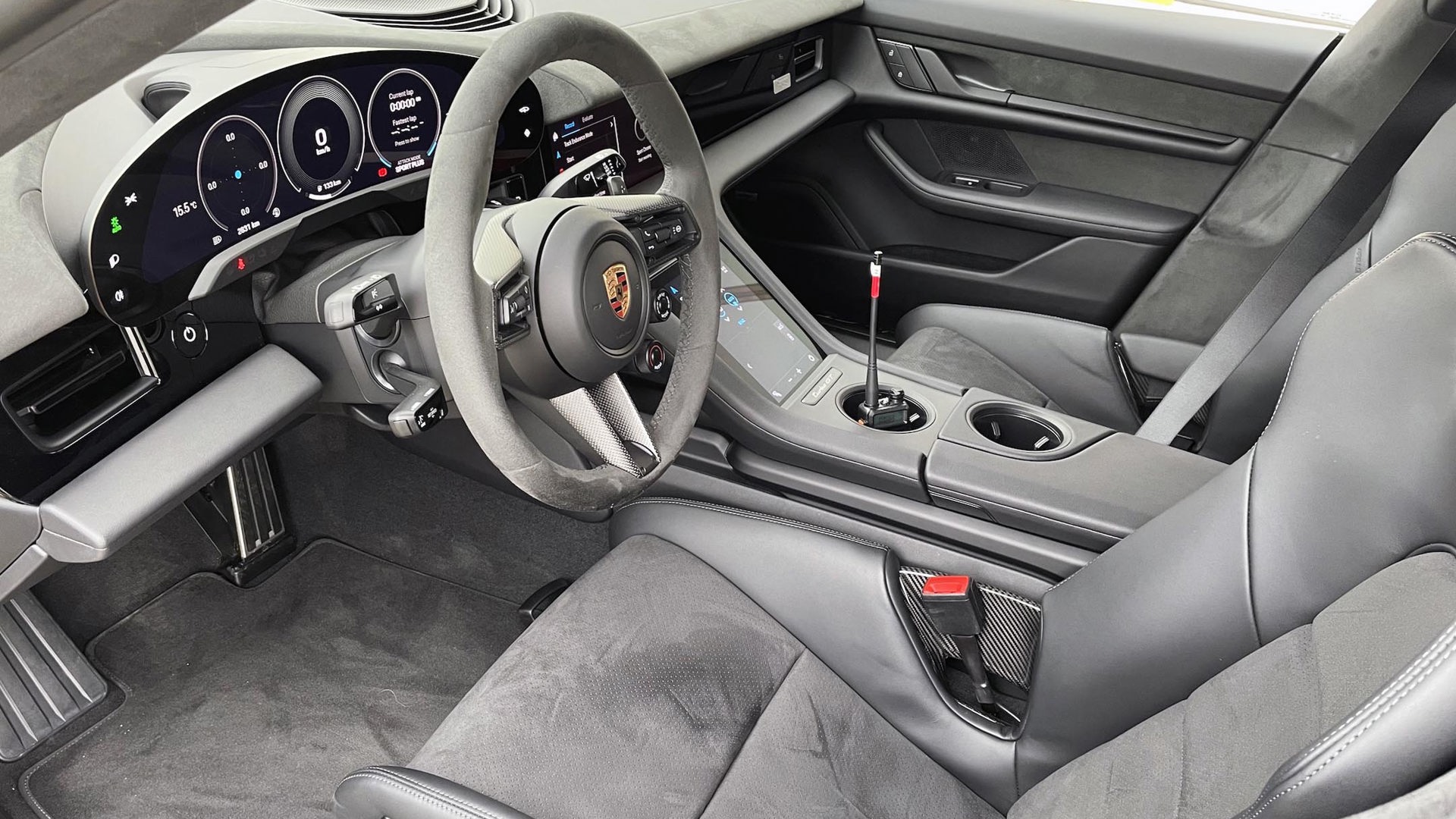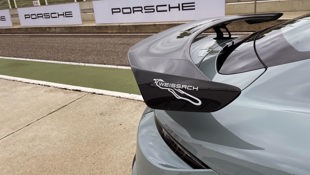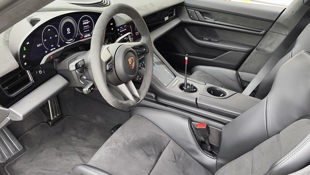Circuito Monteblanco is a fast and technical 4.43-km track not far from Seville, Spain.
I’m in pit lane, belted into the upright carbon-fibre driver’s seat of a 2025 Porsche Taycan Turbo GT – complete with the optional Weissach package, it’s worth pointing out – about to head out for a few laps. Under most circumstances when champing at the bit in pit row, there’s an internal combustion engine somewhere on board, growling, vibrating, and getting all eager when I blip the throttle.
Not here. The all-electric Taycan Turbo GT is dead silent, but I know it’s awake because the gauges are lit. I see the drive dial is in sport plus setting, and “attack mode” is also indicated. Being the most powerful production car Porsche has ever offered in its 75-year history, there’s a peak 1,092 hp and 998 lb-ft of torque under foot and, mercifully, all-wheel drive. In my rearview mirror I see a roll cage where the backseats once were. On the windshield I see raindrops.
Oh, great.
The lead Porsche development driver wants to head out before it really starts raining. So we’re off.
Friend, Not Foe
Graciously, I’m somewhat familiar with this track – although the last car I drove here only had 670 hp. Adding to my adrenaline are the 21-inch Pirelli P Zero Trofeo RS tires this car rides on. Designed specifically for the Taycan Turbo GT with the Weissach pack, there’s barely a hint of tread here – just a few nominal grooves separate these super high-performance summer tires from all-out racing slicks.
With the sport sound activated, the Taycan makes an aggressive space-age whine as we pick up speed, and within the first couple bends of this warm-up lap I can tell the Turbo GT is going to be friend, not a foe. Such is its balance, communication, and tactile steering.
The Porsche team assigned to the Taycan Turbo GT project spent two years honing this land-based electric missile, and much of its on-track poise can be attributed to the car’s standard Porsche Active Ride (PAR) suspension that uses the same dual-chambers as the standard car, but adds powerful electro-hydraulic pumps at each corner to control compression and rebound in real time, thus eliminating the need for anti-roll bars.
It keeps the GT uncannily flat, be that under braking, when cornering, or accelerating, thus maintaining optimal tire contact at all times. Also standard are electronic torque vectoring and massive carbon-ceramic brakes.
With the rain holding off and some heat in the Pirellis, we pick up the pace. The Turbo GT seems to shed half its considerable 2,200 kg (4,850 lb) as velocity increases, lasering from bend to bend and attacking corners with adjustable neutrality. Much of the sedan’s mass is below decks and centrally located, bestowing a low centre of gravity and scalpel-sharp turn-in.
Attack Mode

Coming back to the straightaway that shoots by pit row, the lead driver tells me over two-way radio it’s time to try out attack mode. And all it takes is a pull of the paddle on the right side of the steering wheel to unleash an extra 161 hp for up to 10 seconds at a time. (Just as importantly, a pull of the same paddle cancels it.)
With Attack Mode activated and the accelerator pressed to the floor, the Taycan Turbo GT catapults forth like a leg of jamón ibérico fired from a medieval trebuchet. (OK, maybe not the best metaphor; chalk it up to the lingering taste of that Iberian delicacy.) We touch 260 km/h before the braking zone, where the carbon-ceramics haul me down in a hurry for a sharp right-hander.
The track is damp now and the Taycan’s back end steps out in a rather dramatic fashion. I’d like to think my quick counter-steer brought it back in line, but I suspect the Porsche’s electronics were there way before me. Either way, the high-speed slither was more fun than terrifying.
Launch Mode

And then it was time to experience the Taycan Turbo GT’s launch control – or lunch-launcher, if you will. It goes like this: Stop on the straight; left foot on the brake, right foot on the accelerator; release the brake; take the lord’s name in vain.
By the time you blurt said name, you’ve already reached triple-digit speeds. Porsche says the 2025 Taycan Turbo GT blows through 100 km/h in 2.2 seconds on its way to a 6.4-second dash to 200 km/h. That’s with the optional Weissach package, of course. It should also be noted that it’s only for the first two seconds of launch control that the Turbo GT makes its published 1,092 hp. It drops after that to a still absurd 1,012 hp.
By the fourth time around the track the rain is really starting to come down, and I put the wipers on full. But we’re still flying and these tires are really sticking, just like the Pirelli engineer on site said they would.
Eye-Watering Price
The 2025 Porsche Taycan Turbo GT will be available the third quarter of 2024 in Canada with a starting price of $270,000. That’s with or without the Weissach package that adds a fixed carbon-fibre spoiler on the back, Pirelli P Zero Trofeo RS (versus Pirelli P Zero R) tires, and a rear-seat delete. Sadly, the carbon buckets and factory roll cage won’t be available in North America.
Final Thoughts

One might well ask why this pricey electric special even exists. Surely the 2025 Taycan Turbo S with its peak 938 hp is enough for any sane (or insane) person. Well, there’s a Nürburgring road-approved electric vehicle (EV) lap record at stake here, and the 1,020-hp Tesla Model S Plaid owned it until this juiced Taycan showed up. Porsche driver Lars Kern put paid to that, setting a new lap time around the ’Ring of 7:07.55. As yet, the 1,234-hp Lucid Air Sapphire hasn’t attacked the famed track, so perhaps that California EV maker is sitting this one out.
No matter where it sits in the 1,000-hp EV triumvirate, the Taycan Turbo GT is a surprisingly friendly firebrand that’s ready to elevate electric performance to new heights.



























